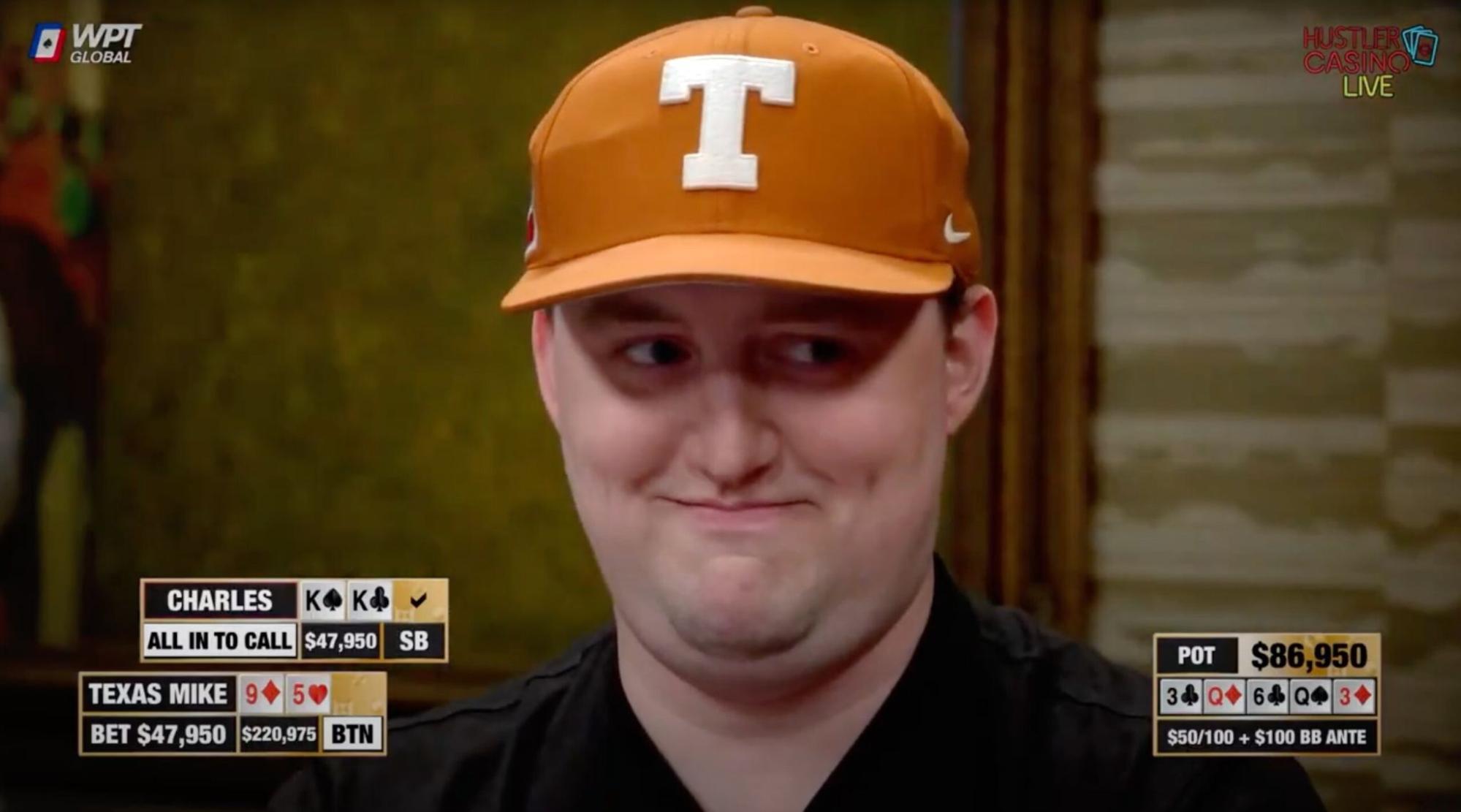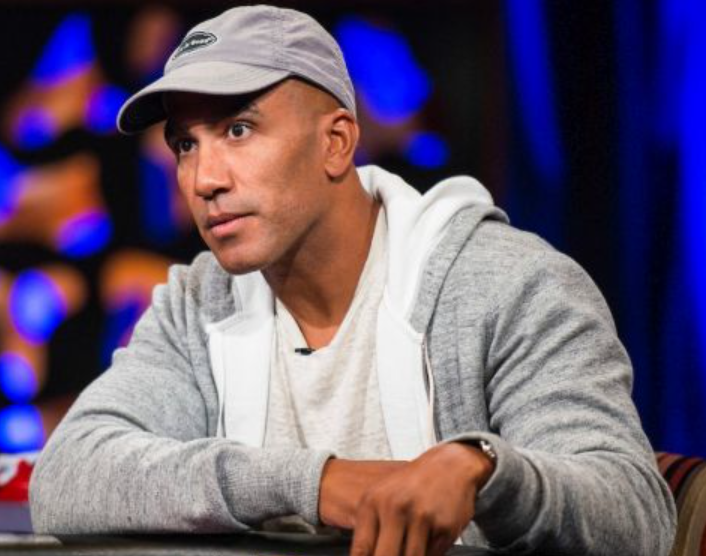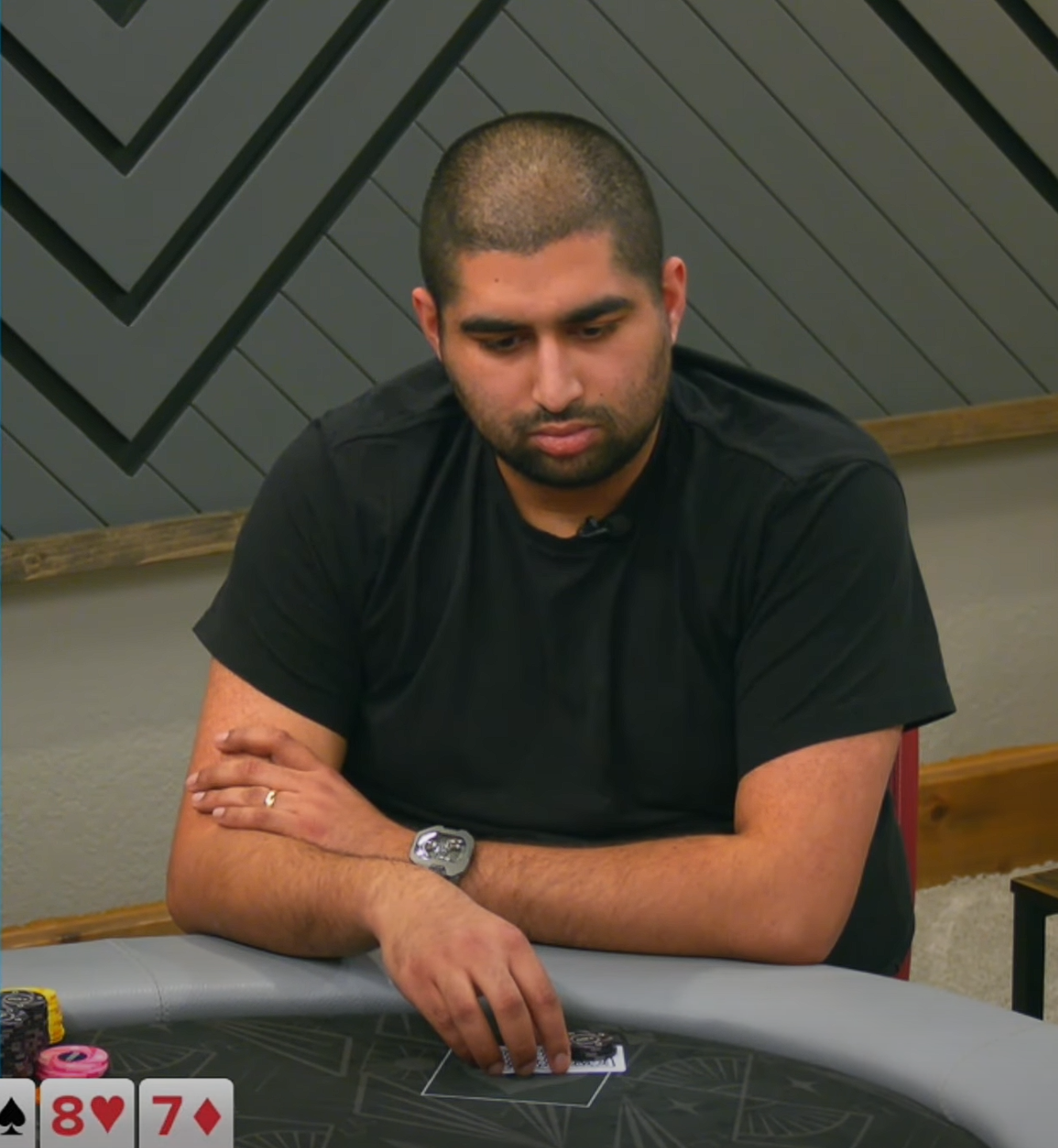Master reading tells with the Live Poker Database
Even strong players give away information. They don’t mean to — but they do. The way they move, talk, and handle their chips says a lot.
The Live Poker Database helps you study poker tells like never before. Filter specific spots, watch player behavior, and compare it to actual hand strength. In this article, we’ll show you a few patterns we’ve discovered.
What are Common Live Poker Tells?
Most poker tells fall into just a few common types.
1. Strong is weak, weak is strong
Players with strong hands often go quiet, tense up, or avoid eye contact. With weak hands, they act confident — sitting back, chatting, or pushing chips quickly.
Bluffing on the river, Brazil God snap-shoves, leans back and keeps talking:
2. Hollywood – exaggerated actions meant to confuse.
Some players like to act — especially when they’re strong. They sigh, shake their heads, cover their faces, and then suddenly bet or raise. It’s often a show: a fake struggle followed by a confident move. In most cases, they’re holding the nuts or a very strong hand.
Jerky King puts on a little Hollywood with quads:
3. Snap decisions
When players bet instantly, they usually made up their mind in advance. It’s either a strong hand or a well-prepared bluff. Either way, snap bets rarely show hesitation.
Facing a bet, Richard snap-jams the river with the nut flush:
4. Shaky hands
Visible shaking often appears with very strong hands. The motion reflects excitement rather than fear. In contrast with a bluff, players usually try to stay still.
Taffe covers his face and open-raises with a shaky hand holding pocket aces:
5. Looking away
This way, players try to avoid revealing information about their hand. It’s often a sign of a very strong hand.
Even before the river card, Thomas announces all-in and looks away holding a full house:
6. Board staring
Long stares before acting often mean uncertainty and indicate a marginal hand. With strong holdings, players decide faster and rarely study the board.
After staring at the board for a while, Urmo Velvelt moves all in with air:
All these behaviors show up most clearly in big pots and high-pressure moments.
Examples from the Database
A Table Talk
First, we watched Texas Mike — a loose recreational player from Hustler Casino Live. He likes gambling and often goes all-in preflop with hands of all kinds.

We filtered his preflop all-ins. Then we looked for any change in his behavior with premium hands. One thing stood out: with strong hands, he became more talkative.
In the hand with pocket kings, he went all-in and added a short, spontaneous comment.
In another hand, he shoved with AK suited and got a funny question from his opponent. Mike laughed, gave a relaxed answer, and even mentioned an earlier bluff.
In contrast, with weaker hands, he didn’t initiate any table talk.
A Shift in Tempo
Let’s look at two tournament hands where Elton Tsang, a regular at Triton high-stakes events, moved all-in on the river.

In one hand where he was bluffing, he grabbed a small stack of chips and pushed them forward in one quick motion. His posture didn’t change, and his timing was fast and direct.
In another hand, holding a full house, he took more time. He shifted in his seat, paused, and used a time-bank card. Then he framed his stacks with both hands and pushed them forward slowly and carefully.
The difference in tempo mirrored the difference in hand strength.
An Impulsive Bet
Next, we looked at Bill Perkins — a high-energy recreational player with a loose-aggressive style. His gestures are animated, and his presence always stands out. So we expected to spot some visible tells.

We reviewed ten river overbets from Bill. Half were strong hands. Half were bluffs.
Only three of the ten were made impulsively — fast motion, no pause, sharp chip delivery. All three came from value hands.
The rest of the bets, including all the bluffs, looked calm — steady posture, careful chip work, no sudden moves:
The pattern was simple: an impulsive bet always meant the nuts.
A Repeated Pose
Lastly, we looked at Nick Airball — a loud, expressive regular from Hustler Casino Live. We reviewed ten hands with a river all-in raise from him. Five were bluffs, five were value bets.
We noticed a distinctive hand placement. One hand forward on the chips, the other resting across the body — on the rail, on his chest, or holding his arm.

This same setup showed up in four of the five bluff hands.
With value hands, there was no pattern. The similar posture showed up only once out of five. In the rest, his hands took on different positions — sometimes crossed, sometimes both on the table.
A certain pose might not mean much on its own. But if it keeps repeating with bluffs — and not with value — that pattern turns into a tell.
The more you look, the more you’ll see
We’ve shown just a small sample of possible poker tells. You can study many more valuable insights in the Hand2Note Live Poker Database.
Spend some time with the database — and you’ll begin to notice what others miss.
Read Next
Master Reading Tells With the Live Poker Database
Even strong players give away information. They don’t mean to — but they do. The way they move, talk, and handle their chips says a lot.
The Live Poker Database helps you study poker tells like never before. Filter specific spots, watch player behavior, and compare it to actual hand strength. In this article, we’ll show you a few patterns we’ve discovered.
What are Common Live Poker Tells?
Most poker tells fall into just a few common types.
1. Strong is weak, weak is strong
Players with strong hands often go quiet, tense up, or avoid eye contact. With weak hands, they act confident — sitting back, chatting, or pushing chips quickly.
Bluffing on the river, Brazil God snap-shoves, leans back and keeps talking:
2. Hollywood – exaggerated actions meant to confuse.
Some players like to act — especially when they’re strong. They sigh, shake their heads, cover their faces, and then suddenly bet or raise. It’s often a show: a fake struggle followed by a confident move. In most cases, they’re holding the nuts or a very strong hand.
Jerky King puts on a little Hollywood with quads:
3. Snap decisions
When players bet instantly, they usually made up their mind in advance. It’s either a strong hand or a well-prepared bluff. Either way, snap bets rarely show hesitation.
Facing a bet, Richard snap-jams the river with the nut flush:
4. Shaky hands
Visible shaking often appears with very strong hands. The motion reflects excitement rather than fear. In contrast with a bluff, players usually try to stay still.
Taffe covers his face and open-raises with a shaky hand holding pocket aces:
5. Looking away
This way, players try to avoid revealing information about their hand. It’s often a sign of a very strong hand.
Even before the river card, Thomas announces all-in and looks away holding a full house:
6. Board staring
Long stares before acting often mean uncertainty and indicate a marginal hand. With strong holdings, players decide faster and rarely study the board.
After staring at the board for a while, Urmo Velvelt moves all in with air:
All these behaviors show up most clearly in big pots and high-pressure moments.
Examples from the Database
A Table Talk
First, we watched Texas Mike — a loose recreational player from Hustler Casino Live. He likes gambling and often goes all-in preflop with hands of all kinds.

We filtered his preflop all-ins. Then we looked for any change in his behavior with premium hands. One thing stood out: with strong hands, he became more talkative.
In the hand with pocket kings, he went all-in and added a short, spontaneous comment.
In another hand, he shoved with AK suited and got a funny question from his opponent. Mike laughed, gave a relaxed answer, and even mentioned an earlier bluff.
In contrast, with weaker hands, he didn’t initiate any table talk.
A Shift in Tempo
Let’s look at two tournament hands where Elton Tsang, a regular at Triton high-stakes events, moved all-in on the river.

In one hand where he was bluffing, he grabbed a small stack of chips and pushed them forward in one quick motion. His posture didn’t change, and his timing was fast and direct.
In another hand, holding a full house, he took more time. He shifted in his seat, paused, and used a time-bank card. Then he framed his stacks with both hands and pushed them forward slowly and carefully.
The difference in tempo mirrored the difference in hand strength.
An Impulsive Bet
Next, we looked at Bill Perkins — a high-energy recreational player with a loose-aggressive style. His gestures are animated, and his presence always stands out. So we expected to spot some visible tells.

We reviewed ten river overbets from Bill. Half were strong hands. Half were bluffs.
Only three of the ten were made impulsively — fast motion, no pause, sharp chip delivery. All three came from value hands.
The rest of the bets, including all the bluffs, looked calm — steady posture, careful chip work, no sudden moves:
The pattern was simple: an impulsive bet always meant the nuts.
A Repeated Pose
Lastly, we looked at Nick Airball — a loud, expressive regular from Hustler Casino Live. We reviewed ten hands with a river all-in raise from him. Five were bluffs, five were value bets.
We noticed a distinctive hand placement. One hand forward on the chips, the other resting across the body — on the rail, on his chest, or holding his arm.

This same setup showed up in four of the five bluff hands.
With value hands, there was no pattern. The similar posture showed up only once out of five. In the rest, his hands took on different positions — sometimes crossed, sometimes both on the table.
A certain pose might not mean much on its own. But if it keeps repeating with bluffs — and not with value — that pattern turns into a tell.
The more you look, the more you’ll see
We’ve shown just a small sample of possible poker tells. You can study many more valuable insights in the Hand2Note Live Poker Database.
Spend some time with the database — and you’ll begin to notice what others miss.















